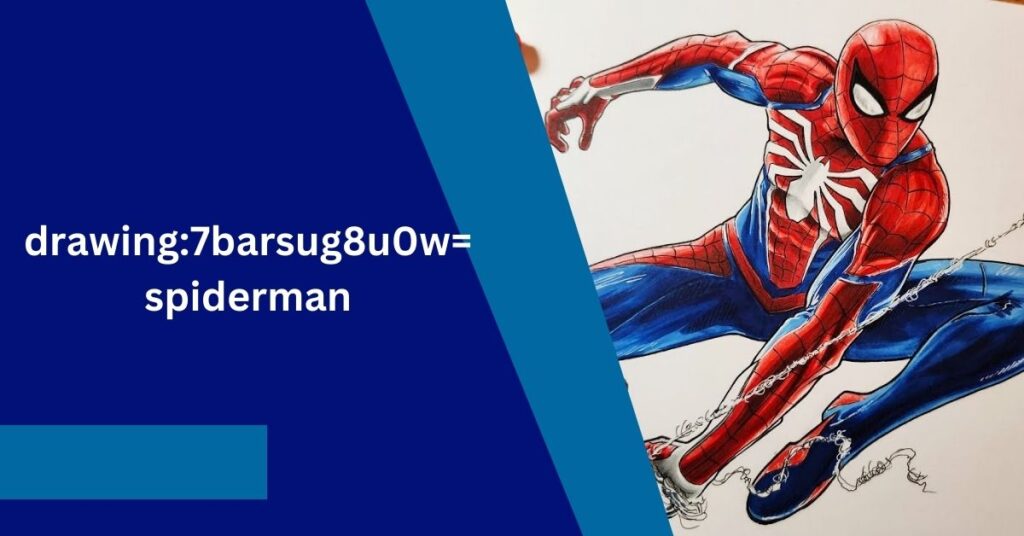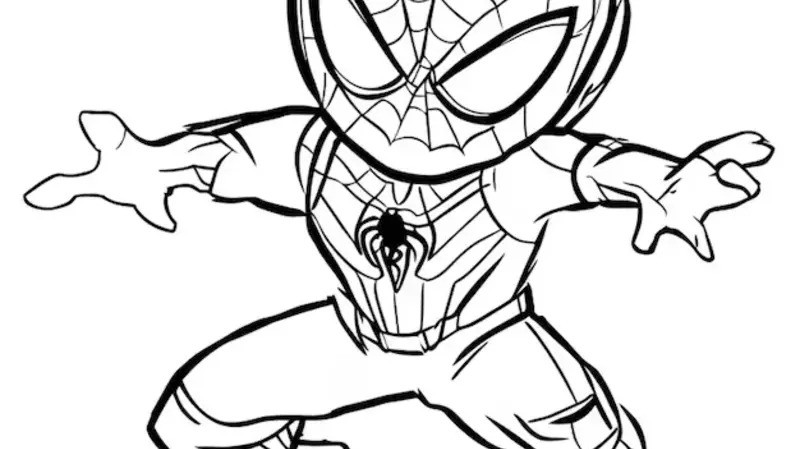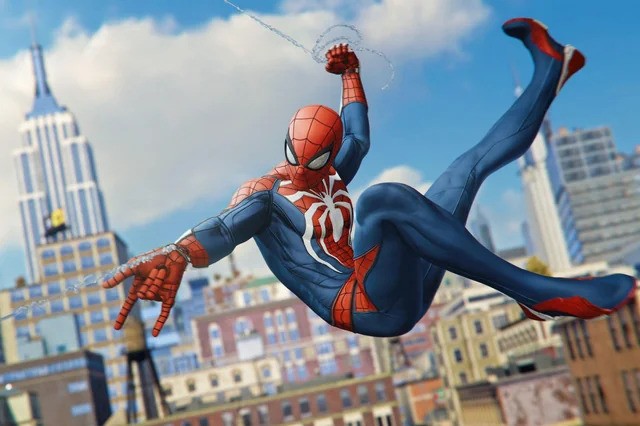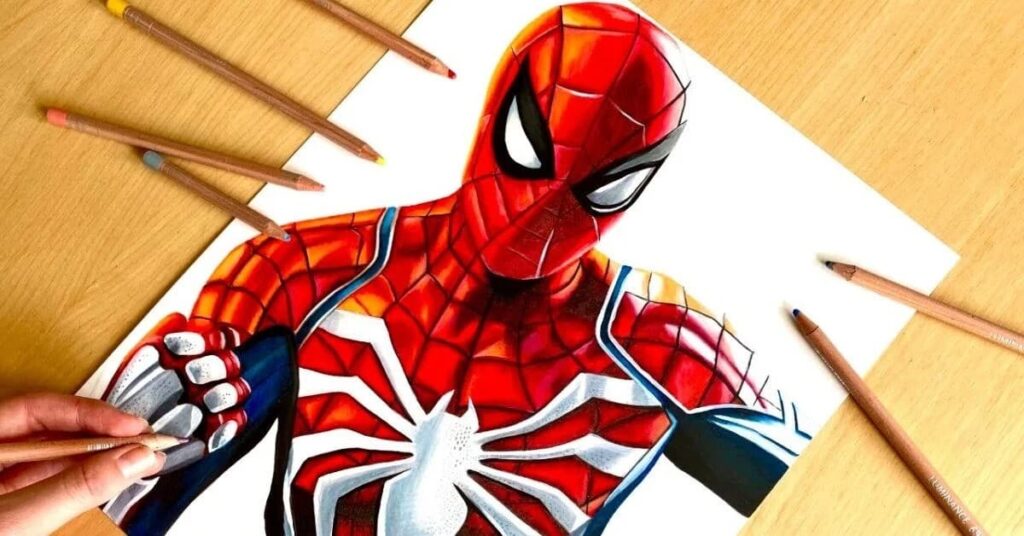drawing:7barsug8u0w= spiderman – Unlock Your Inner Superhero!

drawing:7barsug8u0w= spidermanis one of today’s most iconic superheroes, and drawing him is an exciting challenge for artists. His red-and-blue suit, with detailed web patterns, mixes simplicity and complexity, making it perfect for artists at any level. Whether you’re a beginner practicing basic skills or an expert wanting to refine your craft, Spider-Man’s design offers endless creative possibilities.
This guide will walk you through every step of the drawing:7barsug8u0w= spiderman techniques and let you know more about superhero anatomy and web-slinging art techniques in helping bring this legendary character to life.
Understanding drawing:7barsug8u0w= spiderman:
Spider-Man’s design is a masterpiece of simplicity and detail, crafted to be instantly recognizable while conveying the agility and heroism of the character. Every element of his suit and persona has been carefully designed to tell a story, making it an iconic symbol in popular culture. For artists, understanding the intricacies of Spider-Man’s design is crucial for creating authentic and captivating artwork.
Origins of drawing:7barsug8u0w= spiderman:
Spider-Man was introduced to the world in 1962 as a creation of the legendary duo Stan Lee and Steve Ditko. From his first appearance in Amazing Fantasy #15, Spider-Man’s design stood out among superheroes. Unlike the caped and armored heroes of the time, Spider-Man’s slim, web-patterned suit emphasized his agility and relatability. Over the years, his design has evolved across comics, television shows, and blockbuster movies, but the essence of his character has remained consistent.
His costume tells a story of duality—Peter Parker’s ordinary, relatable life juxtaposed with the extraordinary powers of his superhero alter ego. For artists, delving into Spider-Man’s design evolution offers inspiration and a deep connection to this beloved character.
Key Elements of drawing:7barsug8u0w= spiderman – Shape the Suit!

1. The Red and Blue Suit
Spider-Man’s red and blue suit is one of superheroes’ most recognizable costumes. The colors are bold and dynamic, symbolizing his heroic nature while making him visually striking in any medium.
- Red: Dominates the torso, head, and arms, symbolizing passion and energy.
- Blue: Adds balance and contrast, covering the legs and parts of the arms.
- Integration: The colors are separated by black web patterns, which create a cohesive and structured look.
For artists, maintaining the proper balance of these colors is essential to depict Spider-Man accurately.
2. The Spider Emblem
The spider emblem is a focal point of Spider-Man’s costume, appearing prominently on his chest and back. This symbol ties to his powers and serves as a visual anchor for his design.
- Chest Emblem: A stylized black spider, small and compact in earlier iterations but more extensive and more dramatic in modern adaptations.
- Back Emblem: Often more straightforward in design, complementing the front without overwhelming the overall look.
When drawing the emblem, ensure it is symmetrical and centred to preserve the balance of the design.
3. Webbing Patterns
The intricate webbing patterns on Spider-Man’s suit are arguably its most challenging aspect. They give the suit texture and depth, enhancing its realism and visual appeal.
- Consistency: The webbing radiates from the centre of the chest and head, forming circular and triangular patterns.
- Thickness: Lines are thin but prominent enough to be noticed without overpowering the base colours.
- Flow: The webbing follows the contours of his body, emphasizing his slim, muscular frame.
4. Dynamic Mask Design
Spider-Man’s mask is a defining feature of his identity, combining functionality and mystique. The mask covers his entire face, adding to the anonymity and relatability of the character.
- White Eyes: Large, almond-shaped lenses dominate the mask. These are expressive despite their simplicity, often used to convey emotions in comics and animation.
- Seamless Fit: The mask hugs the contours of his face, creating a sleek, aerodynamic look.
- Webbing Integration: Like the rest of the suit, the mask features intricate webbing that aligns with the design on the torso.
A well-drawn mask captures the heroism and mystery of Spider-Man, making it a centerpiece of your artwork.
Common Mistakes to Avoid When Drawing Spider-Man – Perfect Art!
While Spider-Man’s design may appear straightforward, there are common pitfalls that can detract from the authenticity of your drawing:
- Overcomplicating the Web Patterns: Adding too many lines or uneven lines can clutter the suit and distract from its clean aesthetic. Stick to the original pattern, maintaining consistent spacing and flow.
- Incorrect Proportions: Spider-Man’s head-to-body ratio is critical for capturing his youthful, lean appearance. Avoid making the head too large or small relative to the torso. Pay attention to the proportions of his limbs, ensuring they convey agility and strength.
- Misplacement of the Spider Emblem: The emblem’s position and size should align with the natural contours of the chest and back. A poorly placed emblem can disrupt the suit’s symmetry.
How Can We Add Color and Depth:
Choosing the Right Colors:
- Use vibrant reds and blues for dynamic effects.
- Add dark greys or blacks to enhance contrast, making the colors pop.
- This balance of bright and dark tones brings Spider-Man’s suit to life.
Coloring Techniques:
- Gradually layer colors for smooth transitions.
- Blend colors seamlessly for a polished look, ensuring no harsh lines.
- This technique gives your drawing a soft, realistic appearance.
Creating Depth:
- Add lighter tones for highlights to bring focus to critical areas.
- Deepen shadows around joints for a realistic appearance.
- This enhances the three-dimensional effect, making Spider-Man feel more lifelike.
Read: MyFastBroker – Your Guide to Secure, Efficient, and Insightful Crypto Trading!
What Makes Spider-Man’s Poses So Dynamic?

Understanding Spider-Man’s Physique:
Spider-Man’s physical form is unique among superheroes, characterized by his lean, athletic build. Unlike bulkier heroes like the Hulk or Thor, Spider-Man’s physique reflects agility, speed, and precision. His body is slim yet muscular, emphasizing long limbs and a well-defined torso. This combination complements his acrobatic movements and makes him instantly recognizable as the web-slinging hero. To capture Spider-Man’s athleticism in your artwork, focus on creating fluid lines and balanced proportions.
Dynamic Poses and Movements:
Spider-Man’s dynamic poses are a defining aspect of his character, showcasing his superhuman flexibility and motion. Whether crouching on a ledge, mid-air while web-slinging, or preparing for combat, his poses exude energy and vitality. Capturing this in your artwork involves careful attention to the fluidity and tension within his body. For example, when drawing Spider-Man crouching, emphasize the compression in his legs and the stretch in his back.
Perspective Basics:
Perspective is critical in making Spider-Man’s poses appear three-dimensional and lifelike. Mastering this technique allows you to place the character convincingly within a scene, whether perched on a building or leaping toward the viewer. Foreshortening is particularly important when illustrating Spider-Man. This technique distorts the proportions of his body parts closer to the viewer to create depth and dimension.
Essential Tools and Materials – Master Your Spider-Man Art!
Beginner’s Toolkit:
- Pencils: Use H-grade pencils for initial sketches and B-grade for darker outlines. These pencils offer versatility for sketching light guidelines and defining bold details, making them ideal for beginners still refining their techniques.
- Eraser: A kneaded eraser helps with precision corrections. Unlike standard erasers, it can be molded into specific shapes, allowing you to erase small areas without disturbing the surrounding details.
- Paper: Medium-weight, smooth-textured paper works best for detailed work. This type of paper minimizes smudging and holds pencil strokes well, making achieving clean, professional results easier.
Advanced Tools:
- Fine-tip pens: For crisp inking and defining web patterns. These pens are perfect for creating comic-style outlines, enhancing the sharpness and precision of Spider-Man’s intricate webbing.
- Blending stumps: Essential for smooth shading. These tools help soften pencil strokes and blend shades seamlessly, allowing you to create realistic lighting effects on Spider-Man’s suit.
- Colored Markers: Vibrant red and blue markers bring Spider-Man to life. High-quality markers provide consistent pigmentation, ensuring the iconic colors of Spider-Man’s suit pop vividly on paper.
Digital Tools:
- Software: Use tools like Procreate or Photoshop for digital artistry. These platforms offer customizable brushes and layering options, making experimenting with different styles and effects in your artwork easier.
- Tablets: A pressure-sensitive drawing tablet ensures precision. With features like tilt sensitivity and customizable controls, tablets allow artists to mimic traditional drawing techniques while benefiting from digital flexibility.
Step-by-Step Guide to drawing:7barsug8u0w= spiderman:
| Step | Details |
| Step 1: Sketch Framework | Draw basic shapes (circle for the head, rectangles for the torso, cylinders for limbs). Add a dynamic pose. |
| Step 2: Define Anatomy | Refine muscles, ensure proportional limbs, and sketch web-slinging hands. |
| Step 3: Outline Suit | Add a mask with almond-shaped eyes and a spider emblem on the chest. |
| Step 4: Refine Details | Clean lines and add uniform webbing patterns. |
| Step 5: Add Web Action | Illustrate flowing web strands with curved lines for motion. |
| Step 6: Prepare for Color | Finalize with a fine-tip pen and add light shading for guidance. |
Advanced Techniques for Realistic Effects – Master Shading!

Shading and Lighting:
- Enhance Muscle Contours: Use soft pencils or blending stumps to create shadows along Spider-Man’s muscles, emphasizing his lean yet defined physique. This technique adds depth and realism to your drawing.
- Highlight Key Areas: Focus on areas like Spider-Man’s chest, arms, and head to reflect light sources, giving your artwork a dynamic and lifelike quality. Always imagine where the light is hitting the figure for natural-looking highlights.
Adding Textures:
- Replicate the Suit’s Fabric: Employ cross-hatching and stippling techniques to mimic the unique texture of Spider-Man’s suit. These methods help capture the realistic feel of his costume while adding visual interest.
- Enhance Webbing Depth: Darken the webbing patterns slightly to make them stand out against the suit. This adds an extra layer of detail and makes the overall design pop.
Capturing Motion:
- Dynamic Swinging Poses: For action-packed scenes, exaggerate the angles of Spider-Man’s limbs to convey fluidity and agility. This technique is especially effective for iconic web-slinging poses.
- Blurred Lines for Speed: Add trailing, curved lines around Spider-Man to illustrate motion and energy. This approach works well when depicting fast, dynamic movements, like swinging through a cityscape.
These advanced techniques are tailored for artists aiming to create realistic, engaging Spider-Man artwork that stands out. By focusing on these elements, you’ll capture the true spirit of the web-slinging superhero and impress viewers with your attention to detail.
Where Can Artists Find Spider-Man Inspiration?
Artists can draw inspiration from iconic Spider-Man creators like Steve Ditko, John Romita Sr., and Mark Bagley, whose works shaped the character’s legacy. Resources like “How to Draw Comics the Marvel Way” provide practical techniques, while platforms like DeviantArt and Reddit offer vibrant communities for sharing artwork and receiving feedback.
Online tutorials on YouTube and Skillshare provide step-by-step guidance for beginners and professionals alike. Participating in art challenges or fan art events on Instagram can also spark creativity and build connections within the Spider-Man fan community.
Unique Artistic Challenges with drawing:7barsug8u0w= spiderman:

Expressing Personality Through Poses:
- Highlight Spider-Man’s playful and energetic character by drawing him in crouching or web-slinging poses.
- Focus on dynamic movements that showcase his agility and superhero confidence.
Incorporating Backgrounds:
- Create engaging urban settings with skyscrapers, rooftops, or iconic city bridges to add context and drama.
- Use soft gradient techniques to introduce depth and realism to cityscapes, making drawing:7barsug8u0w= spiderman environment feel alive.
Experimenting with Styles:
- Reimagine Spider-Man in diverse artistic styles, such as classic comic book aesthetics, minimalist designs, or detailed hyperrealism.
- Allow your style to shine while maintaining the essence of this iconic superhero.
Read: Hazelviber.net – The Ultimate Guide to This Innovative Communication & Learning Platform!
Frequently Asked Questions (FAQ’s)
1. What makes drawing:7barsug8u0w= spiderman design so appealing to artists?
Spider-Man’s design stands out because of its balance between simplicity and complexity. The bold red and blue color scheme, iconic spider emblem, and intricate webbing allow artists to experiment with various styles while maintaining a recognizable silhouette.
2. How can I improve my Spider-Man drawing’s realism?
To enhance realism, focus on the anatomy of Spider-Man’s body, emphasizing his lean muscles and agility. Use shading and light contrast to define his physique and give depth to his suit. Paying attention to the contours of the webbing will also add a sense of three-dimensionality.
3. What are some tips for creating a dynamic Spider-Man pose?
To create dynamic poses, start with a strong sense of motion. Use foreshortening techniques to distort limbs, showing Spider-Man in action, like swinging or crouching. Keep the posture fluid and expressive to capture his agility and the excitement of his movements.
4. How do I choose the suitable materials for drawing Spider-Man?
Beginners should use basic pencils and smooth, medium-weight paper to capture Spider-Man’s design, while advanced artists may opt for fine-tip pens and colored markers for precise lines and vibrant hues. Digital artists can use software like Procreate to refine their work and achieve professional-level detail.
5. Can I experiment with different Spider-Man styles in my artwork?
Absolutely! Artists are encouraged to reimagine Spider-Man in various styles, from classic comic book aesthetics to modern, minimalist approaches. The flexibility of the character’s design allows for creative expression, whether through realistic details or stylized interpretations.
Conclusion
Mastering the art of drawing:7barsug8u0w= spiderman is exciting and challenging for all artists. It can be in terms of profoundly understanding his iconic suit design in red and blue or even capturing the dynamic poses of Spider-Man.
Every detail enhances the character. One can develop technical skills focusing on patterns of his unique physique, patterned webbing, and an expressive mask design.
Read more:




